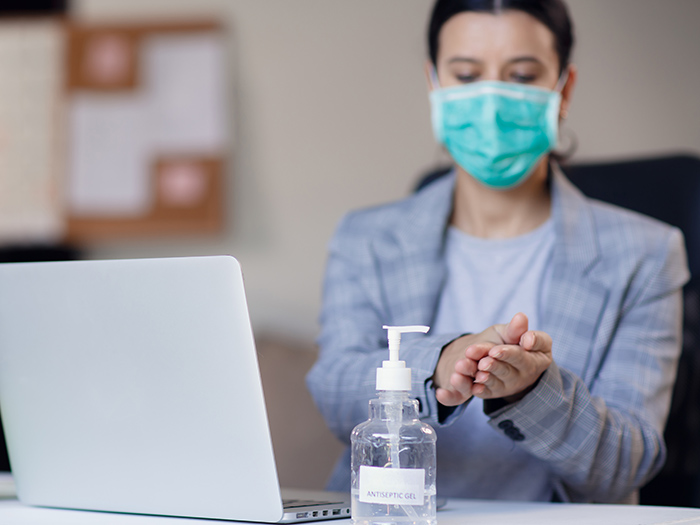Top 10 Lessons Learned in Helping Workers Move Past COVID-19

There’s no doubt COVID-19 has had an impact on the workplace. Not the least of which is the mental and physical struggles that employees who’ve been affected by the illness may experience as they return to work.
There are about 6.65 million confirmed cases of COVID-19 in the U.S. and nearly 200,000 people who have died from the illness as of writing. With such high numbers, employers are striving to provide safe workplaces and to help workers feel confident about moving past the illness.
Tammy Bradly, vice president of clinical product development at Coventry, and Tim Howard, senior vice president of field case management for Genex Services, discussed the top lessons they’ve learned about COVID-19, its impact on the workplace and how to help employees get back to work after the illness.
Here are the lessons they’ve shared:
1) COVID-19 Is Different from Other Illnesses
“It’s very different,” said Bradly.
“The most common injury types we typically see in workers’ compensation are musculoskeletal in nature. With COVID-19 you can’t just give someone a pill or put them in a cast for a few weeks, send them to physical therapy and then back to work. With COVID, we’re still learning about the virus and trying to gain knowledge over time about what the long-term prognosis is going to be.”
2) Return to work plans must reflect COVID-19’s varied impact on workers
“There is no one size fits all with COVID,” said Bradly.

Tammy Bradly, vice president of clinical product development, Coventry
Young workers who are diagnosed with COVID-19 may experience no symptoms and be back to work in two weeks. Older workers with comorbid conditions may suffer complications that require hospitalization and be out of work for weeks or months.
“Getting a worker back to work is going to vary based on the individual and the severity of the illness,” she said.
“Employers also have to consider many things: whether the workers do an office job and are sedentary, or are they doing manual labor? All those things have to be taken into consideration when we address a return-to-work plan.”
3) Employers Must Be Flexible
With so many potential outcomes, from a person not having any symptoms to possibly being hospitalized for weeks, Howard said employers will have to be flexible about arrangements for how workers return to the workplace.
“Flexibility is going to be key,” he said.
“A lot of people who’ve been diagnosed with this illness have a recovery that’s quite long. They’re very tired and there are lingering aftereffects. I think an employer has to understand and empathize with that.”
He added employers will need to offer different paths back to work, such as allowing a gradual return to work, letting an employee work half the week at home and half in the office, or allowing permanent work from home for some.
4) Communicate Often with Employees
It would not be surprising for a person who’s had COVID-19 to be concerned about possibly becoming re-infected when returning to the workplace.
Unlike other illnesses or injuries, Howard said employers should be aware that coworkers also may have anxieties about working in close proximity to a person who’s had the illness.
To help reduce anxiety, Bradly suggested employers communicate frequently and clearly with all employees.
“Provide them with the latest and most credible information surrounding the virus,” Bradly said. “The Centers for Disease Control website has a section just for employers and bringing employees back to work and how to manage that.”
5) Make the Workplace as Safe as Possible
At a minimum, all employers should be abiding by the CDC guidelines in creating a safe workplace for employees and should also look at their state rules, which, in some cases, may be more strict.
Bradly mentioned that in Pennsylvania, for instance, if an employee tests positive for COVID-19, employers are required to do temperature checks of all employees for two weeks.
“Having that employer show care and concern for all employees and making sure they understand all the things the employer is doing to protect them is going to reduce anxiety, not only the employee who’s coming back with a fear of re-infection, but also for those who’ve been working and have anxiety about being exposed to it.” — Tammy Bradly, vice president of clinical product development, Coventry
Some tips for making a workplace safer include increasing ventilation, if possible, limiting the number of people in the workplace at a time, assigning employees permanent work stations and reducing the use of shared equipment.
6) Listen to Employees and Medical Experts
Howard said employers need to listen to what physicians, other health professionals and the employees themselves have to say about their readiness to return to work, especially when coping with aftereffects of the virus, such as fatigue.
“It is going to be worse if an employee comes back and is tired and then gets reinjured, especially if their job is physical in nature,” he said.
7) Offer Mental Health Intervention
Bradly noted employers can help ease the anxiety that a person may feel post-COVID by offering mental health services.
“Having that employer show care and concern for all employees and making sure they understand all the things the employer is doing to protect them is going to reduce anxiety, not only the employee who’s coming back with a fear of re-infection, but also for those who’ve been working and have anxiety about being exposed to it,” she said.
8) Case Managers Need to Stay Informed About COVID-19
Howard said case managers need to keep up-to-date on the latest information about the illness from trusted sources such as the CDC and World Health Organization.

Tim Howard, senior vice president of field case management, Genex Services
Case managers can use that information to educate workers about safety in the workplace.
That information also can be tailored to fit a particular workplace.
“At Genex, we have a dedicated guidelines team that takes that information and adapts it to best practices used in workers’ compensation,” Howard explained. “We’re in our ninth revision of our proprietary guideline since the pandemic started.”
Case managers also can help detect and then ease workers’ concerns about getting back to work.
“They’re able to uncover hidden anxiety that might keep a person from going back to work,” Howard said.
9) Using Apps for Health Screening
According to Howard, more employers are using health screening apps before letting workers into the workplace.
He believes such products may be useful for documenting workers’ responses to questions about their own health and for showing that employers are doing what is appropriate to maintain a safe workplace.
“I think it’s a good thing, because, everyone’s concerned about health and safety. But at some point, it’s going to become a legal issue as well,” he said.
“When those claims start to roll in, relative to who’s responsible legally, the question may be ‘What did you do to make sure that the workplace is safe.’ ”
10) Consider Hiring a Medical Director
Bradly said one of Coventry’s clients recently hired a medical director as a consultant to help them update policies and procedures related to COVID-19 such as how to screen for the illness.
“They’re concerned, because we’re about to hit the flu season. [They want to know] how do they handle, ‘Does this employee have COVID-19 versus the flu?’ ” &










